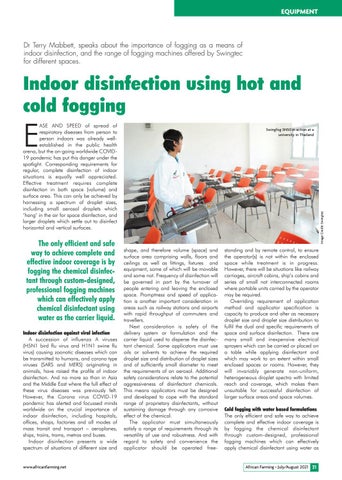S06 AF July August 2021 Crops 2_Layout 1 27/07/2021 06:53 Page 21
EQUIPMENT
Dr Terry Mabbett, speaks about the importance of fogging as a means of indoor disinfection, and the range of fogging machines offered by Swingtec for different spaces.
Indoor disinfection using hot and cold fogging
E
ASE AND SPEED of spread of respiratory diseases from person to person indoors was already wellestablished in the public health arena, but the on-going worldwide COVID19 pandemic has put this danger under the spotlight. Corresponding requirements for regular, complete disinfection of indoor situations is equally well appreciated. Effective treatment requires complete disinfection in both space (volume) and surface area. This can only be achieved by harnessing a spectrum of droplet sizes, including small aerosol droplets which ‘hang’ in the air for space disinfection, and larger droplets which settle out to disinfect horizontal and vertical surfaces.
Indoor disinfection against viral infection A succession of influenza A viruses (H5N1 bird flu virus and H1N1 swine flu virus) causing zoonotic diseases which can be transmitted to humans, and corona type viruses (SARS and MERS) originating in animals, have raised the profile of indoor disinfection. And no more so than in Asia and the Middle East where the full effect of these virus diseases was previously felt. However, the Corona virus COVID-19 pandemic has alerted and focussed minds worldwide on the crucial importance of indoor disinfection, including hospitals, offices, shops, factories and all modes of mass transit and transport – aeroplanes, ships, trains, trams, metros and buses. Indoor disinfection presents a wide spectrum of situations of different size and
www.africanfarming.net
Image Credit: Swingtec
The only efficient and safe way to achieve complete and effective indoor coverage is by fogging the chemical disinfectant through custom-designed, professional fogging machines which can effectively apply chemical disinfectant using water as the carrier liquid.
Swingfog SN50 in action at a university in Thailand
shape, and therefore volume (space) and surface area comprising walls, floors and ceilings as well as fittings, fixtures and equipment, some of which will be movable and some not. Frequency of disinfection will be governed in part by the turnover of people entering and leaving the enclosed space. Promptness and speed of application is another important consideration in areas such as railway stations and airports with rapid throughput of commuters and travellers. Next consideration is safety of the delivery system or formulation and the carrier liquid used to disperse the disinfectant chemical. Some applicators must use oils or solvents to achieve the required droplet size and distribution of droplet sizes and of sufficiently small diameter to meet the requirements of an aerosol. Additional safety considerations relate to the potential aggressiveness of disinfectant chemicals. This means applicators must be designed and developed to cope with the standard range of proprietary disinfectants, without sustaining damage through any corrosive effect of the chemical. The applicator must simultaneously satisfy a range of requirements through its versatility of use and robustness. And with regard to safety and convenience the applicator should be operated free-
standing and by remote control, to ensure the operator(s) is not within the enclosed space while treatment is in progress. However, there will be situations like railway carriages, aircraft cabins, ship’s cabins and series of small not interconnected rooms where portable units carried by the operator may be required. Overriding requirement of application method and applicator specification is capacity to produce and alter as necessary droplet size and droplet size distribution to fulfil the dual and specific requirements of space and surface disinfection. There are many small and inexpensive electrical sprayers which can be carried or placed on a table while applying disinfectant and which may work to an extent within small enclosed spaces or rooms. However, they will invariably generate non-uniform, heterogeneous droplet spectra with limited reach and coverage, which makes them unsuitable for successful disinfection of larger surface areas and space volumes. Cold fogging with water based formulations The only efficient and safe way to achieve complete and effective indoor coverage is by fogging the chemical disinfectant through custom-designed, professional fogging machines which can effectively apply chemical disinfectant using water as
African Farming - July/August 2021 21






